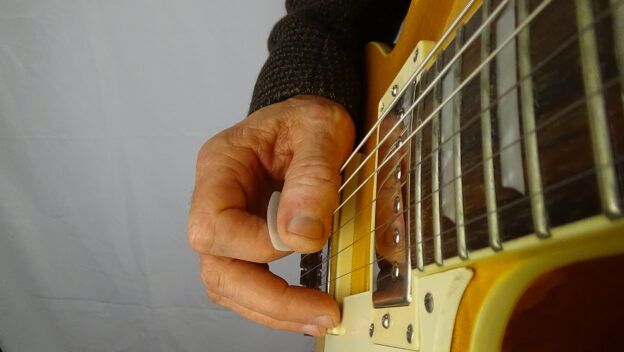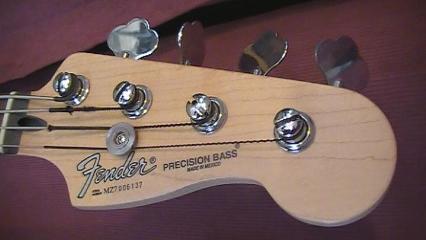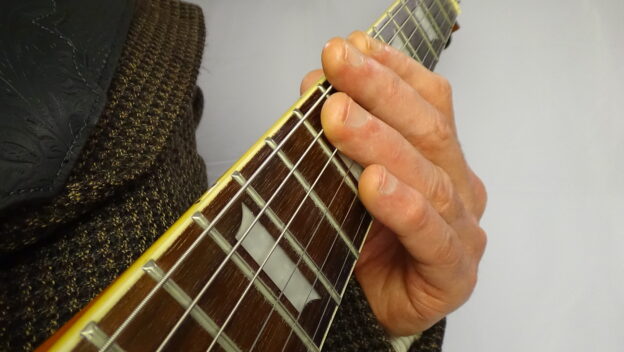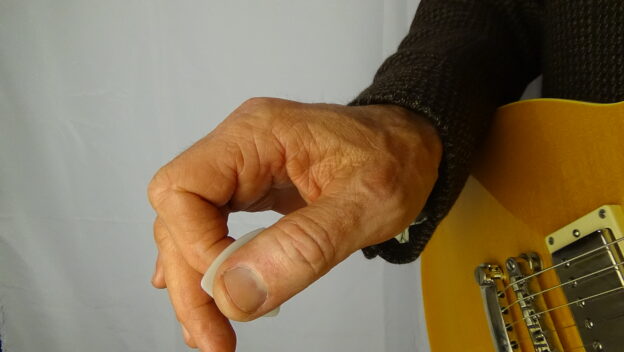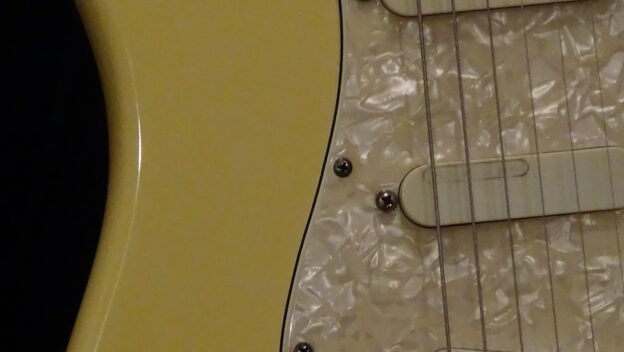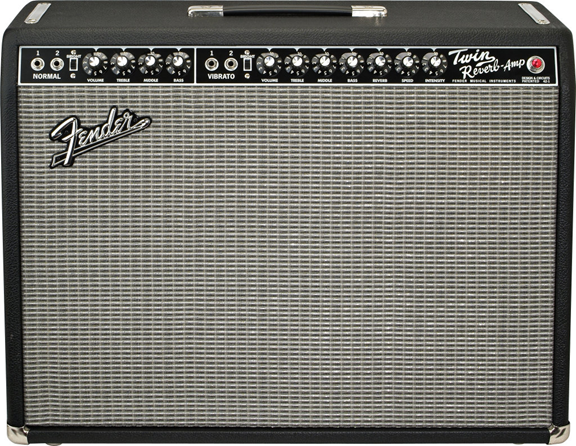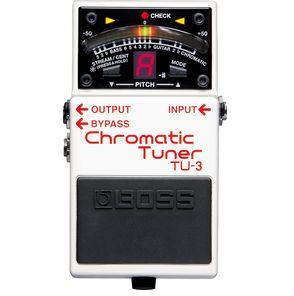By Chad Crawford, PMI Guitar Instructor
If you are new to guitar or even somewhat experienced, you may be overwhelmed by all the options regarding types of guitars, strings, and picks. After you read this brief article, you will be an expert on guitar hardware!
There are two basic categories of guitar: acoustic and electric. We will discuss the nature and purposes of each below.
Acoustic Guitars
Acoustic guitars have a large hollow wooden box for a body, with a round hole or some other kind of opening to naturally amplify the sound of the strings. There are two main types of acoustic guitars: classical and folk. The classical guitar, as the name implies, is meant for playing classical style music. You can identify these guitars easily by the presence of three nylon strings which look like clear plastic. The folk guitar uses steel strings, with the larger strings also having a bronze wrap. Folk guitars are typically larger than classical guitars and have a narrower neck to facilitate chords. Folk guitars are louder and have brighter tone than classical guitars. While either of these types of guitars may come equipped with an option for electronic amplification, we still consider them acoustic guitars.
The dobro or resonator is a specialty acoustic guitar which uses internal metallic plates to amplify the sound of the strings. While it looks much like a standard acoustic guitar, the playing techniques and sound are different enough that many consider the dobro a different instrument from a traditional guitar.
Electric Guitars
Electric guitars come in two main varieties: solid body and hollow body. The hollow body has open chambers in the body with holes, similar to an acoustic guitar, for naturally amplifying the sound of the strings. Despite the opened chambers, they are not nearly as loud as a true acoustic guitar and thus require amplification to be of any practical use. They have a warm (less treble) sound quality which is great for blues, jazz, and other clean (non-distorted) tones. Due to the resonant chambers they tend to present feedback (prominent squealing sound) at moderate amplifier volumes.
The solid body guitars have, as the name implies, a completely solid body section with no open resonant chambers. Some solid bodies have internal resonant chambers with a view toward enhancing sound quality, but these chambers will not be opened to the air so they provide no sound amplification and no feedback problems.
Before we go farther with discussing solid body guitar types, let’s take a moment to consider several very important factors in guitar construction: pickups, neck profile, and frets.
Pickups are coils of wire wrapped around magnets. The magnets generate a magnetic field and the coils pick up variations in the strength of the field through electro-magnetic induction. When we strike a metal guitar string placed within the field of pick up, the string vibration disturbs the field. The coils pick up on the changes in the magnetic field and generate a tiny electronic signal, which we send out to an amplifier through a cable.
There are two main types of guitar pick ups: single coil and humbucker. Single coils have one coil of very thin wire wrapped around a series of magnets, usually one magnet per guitar string, arranged so that each magnet is directly under a string. Single coils produce a sound that emphasizes treble and bass frequencies. They tend to pick up electronic noise such as radio frequency signals generated by appliances and lights.
Humbuckers are made of two magnet/coil sets merged into one big coil. They tend to produce a stronger signal which is helpful with distorted guitar tones. They also have a built-in tendency to reject extraneous electronic signals so they do not make as much noise as single coils. They generally have a more balanced frequency response than single coils so that they do not emphasize treble and bass frequencies like single coils.
Neck Profile refers to the depth of the neck and the radius (curvature) of the fretboard. A low number radius like 9 means the neck is relatively curved which is helpful for making bar chords since it fits the shape of the hand well. Necks with a flatter fretboard will have a higher radius number such as 14. These necks will also tend to have less depth from the fretboard face to the back of the neck. These flatter necks are more helpful for playing scales and arpeggios. A Compound Radius neck will have a radius that changes from curved near the nut to flat near the body, so that you can make chords easily near the nut while also having the advantage of flatter neck above the 12th fret for facilitating fast scale runs and extreme bends.
Frets come in different sizes and materials. The standard fret wire alloy supplied with most guitars is reasonably durable and provides a well-balanced tonal quality. Stainless steel frets last longer than typical frets but cost more and tend to emphasize treble frequencies. Medium frets are suitable for most hobbyists. For progressive rock, metal, or other high-speed styles, the larger jumbo frets will serve better for high-speed scales, sweep arpeggios, and extreme bending.
Most solid body electric guitars bear a similarity to one of two iconic electric guitars: The Fender Stratocaster and the Gibson Les Paul. The standard Stratocaster features three single coil pickups, a 25.5-inch scale length (measurement from nut to bridge), and a spring-action floating bridge with a bar for activating the spring action. The floating bridge allows you to apply a pitch variation to the strings through pushing and pulling the bar. The longer scale length means the strings are tighter and the frets are a bit farther apart, so Stratocasters are a little more challenging to play. The body wood is typically alder which enhances the single coil tendency toward emphasizing treble and bass, giving the Stratocaster a bright, glassy chime in the treble range combined with rich, deep bass response. The neck pickup provides a more balanced overall tone which is good for playing cleaner tones, while the bridge pickup provides a more treble enhanced tone which is useful for distortion sounds. The middle pick is reverse wound from the neck and bridge, providing a tone that is in between the neck and bridge in terms of treble enhancement. The middle coil provides noise cancellation similar to a humbucker whenever the middle coil is activated at the same time as one of the other coils.
Many modern rock guitars are spin-offs of the Stratocaster, often called “super-strats”. The super strats will have more pointy bodies and head stocks, with flatter neck profiles and humbucker pick ups to facilitate high distortion, high speed solos.
Gibson Guitars designed the Les Paul around a dual humbucker pick up configuration, with a shorter 24.75-inch scale length. The humbuckers deliver a strong signal for maximum distortion, while still yielding a great balanced tone for cleaner sounds. The mahogany body tends to de-emphasize treble, leading to a tone that many guitarists describe as “darker”. The shorter scale length means the frets are closer together and the strings are not drawn as tight, so these guitars can be a bit easier to play than the Stratocasters, especially for smaller hands. Like the Stratocaster, the pickup closer to the neck will provide a balanced tone which is great for clean sounds, and the neck pick up will provide more treble clarity which is helpful with distortion tones. The Les Paul also features a fixed bridge for more stable tuning and better sustain than Stratocaster type guitars.
If you are new to guitar and not sure what kind of guitar to start with, I recommend solid body electric guitars for all students of guitar primarily interested in styles other than classical. Solid body electric guitars have small, flat bodies, thin necks, and pliable strings, which altogether makes them easier to play than other types of guitars. After developing a certain level of technique proficiency, you will then have a better experience of playing other types of guitars. Both Fender and Gibson offer entry level, low cost Squier and Epiphone versions of their higher end guitars, for very reasonable prices in the range of $200.
Strings
Strings come in different sizes and materials. Bronze strings are for acoustic folk type guitars, and nickel-plated steel is for electric guitars. Thin strings are more pliable and easier to bend, so they are helpful for beginners and those who wish to play at very high speeds. Thicker strings provide a more balanced overall tone with better sustain. String sets with a .010-gauge high E string are a good balance between tone and playability. I use Martin .011 Gauge strings for my acoustic guitars, and D’Addario XL .010-gauge strings for my general-purpose electric guitars.
The term “action” refers to the height of the strings above the frets. Lower action means less pressure and less time to fret a note, so it may seem to make the guitar easier to play. The tradeoff is more fret buzz, more difficulty with bending, and more difficulty with sweep picking techniques. The manufacturer specified string height is typically a good balance.
Picks
Picks also come in many materials, shapes, and thickness. A floppy pick leads to weak pick attack and reduced speed and control. For bronze string acoustic guitars, I use a medium gauge pick of .8 mm for a good balance of control and playability. For electric guitar I use thicker and more stable heavy gauge 1.5 mm large triangular picks by Clayton. A larger pick will provide more surface area and thus better grip and less unwanted shifting. Different materials provide varying grip, tone, and response. I prefer large, thick acetyl picks for a good balance between durability, grip, and tone. Picks are cheap, so you can afford to experiment to find the one that suits you best.
Copyright © 2005 Palmetto Music Institute. All Rights Reserved.

